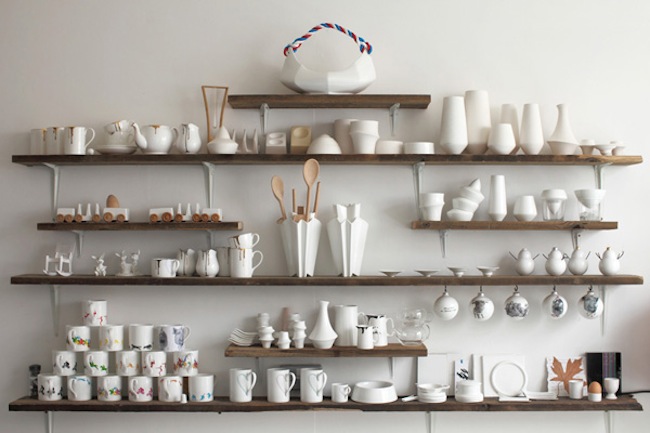British-Japanese designer Reiko Kaneko creates Japenese-inspired works through the traditions of English porcelain-making, while using technology to drive the medium forward.
Her biography states that she “wants to prove that the fine bone china industry has moved on from its twee reputation.” Her world is not of 18th century figurines, but of modern shapes that are typically witty or simple Japanese-inspired forms.
The process for bone china began in 1748 by two London porcelainists, Thomas Frye and Edward Heylyn. They added bone ash to their porcelain mixture, which caused the finished product to become brilliantly white, durable and luminescent. The process was refined around 1790 by Josiah Spode, from Stoke-on-Trent in Staffordshire. Spode’s process is the basis for all bone china made today. Kaneko’s studio, which she established in 2007 in London’s East End, is now based in the same city where Spode refined the bone china process.
With that historical note as a jumping-off point, Kaneko uses 3D-modeling programs to imbue tableware with experimental or theatrical ideas. She’s enthusiastic about the fine food industry and desires her work to give a fresh perspective to food and drink.
Kaneko spent her childhood in Japan and studied at the Central Saint Martins College of Arts and Design in London.
Above image: Ceramic tableware designs by Reiko Kaneko.
Any thoughts about this post? Share yours in the comment box below.

Reiko Kaneko’s tiered sandwich stand, inspired by the Mad Hatter from “Alice in Wonderland.”

An oyster cocktail cup, which the designer states “challenges the idea of traditional drinking vessels.”

Kaneko’s “Drip Tease” teaset, with tea spills done in gold.

The designer says the Crack of Thunder mug calls on the Japanese practice of gluing broken china together and gilding the crack with gold to accentuate the imperfection, making a defect an enhancement.

Kaneko made a series of bamboo glasses which, in addition to the glasses above, include tumblers, sake decanters and shotglasses.


From the Petal series, a jug and a dish which draw their shapes from flowers.

Workers producing this series of breadbaskets dubbed the vessel The Boat because it resembles a viking longship. A nautical-looking rope serves as a handle.

Add your valued opinion to this post.